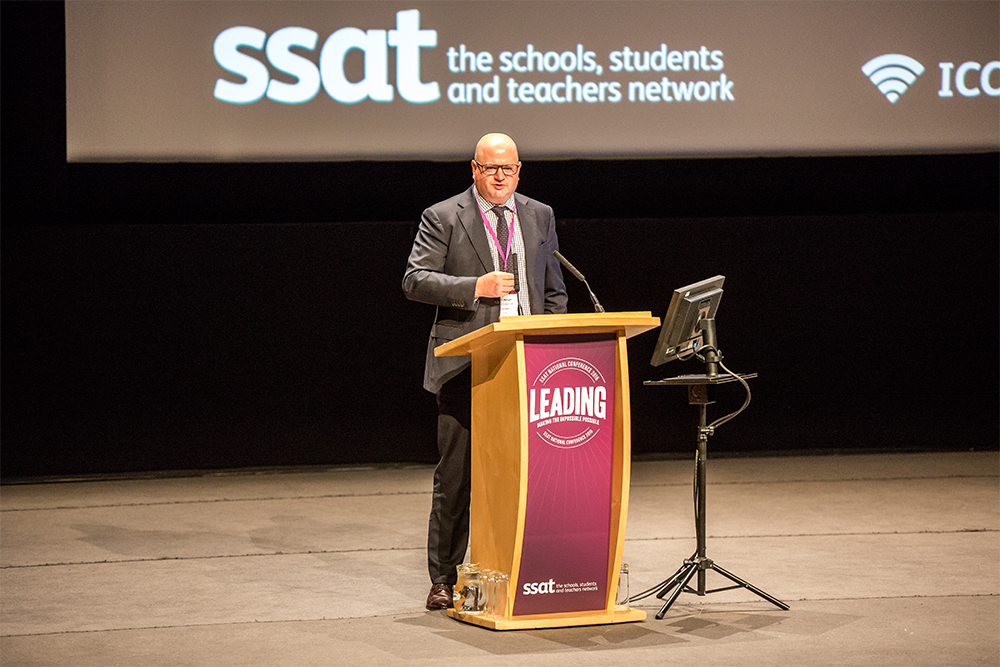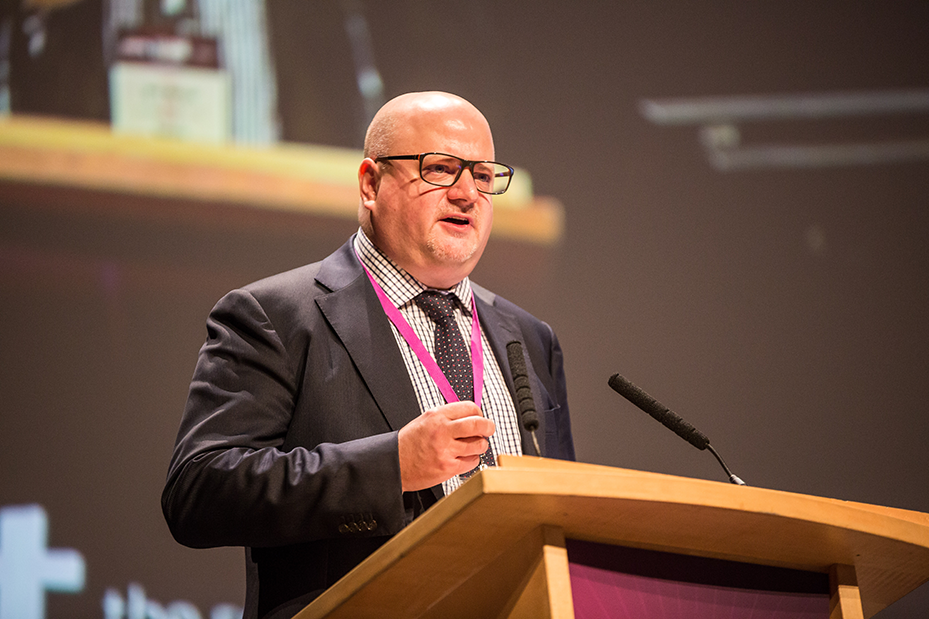 Pictured above giving a mainstage presentation at the SSAT National Conference 2016, Steyning Grammar School headteacher and former investment banker Nick Wergan has built on his wide range of experience to create constant improvement in leadership throughout the school…
Pictured above giving a mainstage presentation at the SSAT National Conference 2016, Steyning Grammar School headteacher and former investment banker Nick Wergan has built on his wide range of experience to create constant improvement in leadership throughout the school…
Being asked what sort of leader you are suggests the questioner has not fully grasped what leadership is about. Leaders develop an armoury of skills that are employed according to context – from short term, instinctive responses to events, to the longer term, strategic and sustainable leadership needed to deliver an aspirational school development plan. A good leader responds chameleon-like to the situation they are faced with.
Schools are increasingly good at developing leadership skills explicitly as part of professional development programmes. However, the external accountability systems against which schools are held accountable remain stacked against the longer-term leadership needed to deliver sustainable success.
Dr Russell Quaglia remarked at the 2015 SSAT national conference that school leaders don’t like to think they are doing anything better than others, and I fall into that camp, generally feeling humbled by the fantastic leadership I witness in schools.
Several SSAT conferences ago Andy Hargreaves presented passionately on ‘performance beyond expectations’, detailing how successful leadership in sectors as diverse as education, automotive and retail could learn from each other. At first glance there seems to be little similarity between the leadership worlds I have inhabited, in investment banking and comprehensive education. They might both be about investment, one more literal and one more holistic, but, putting aside the obvious difference in outcomes, I have found much that each sector can learn from the other.
Leadership in investment banking and in comprehensive education are both about investment… [there is] much that each sector can learn from the other
Influential leadership at every level
Successful teams in industry set clear goals, monitor progress and intervene to ensure the projects are delivered successfully. In schools we also do precisely this, albeit with substantially less resources, but frequently with more precise leadership intent. We set out a clear vision for our students, use data meaningfully to identify where students are falling behind, and step in to support them individually.
In an educational setting data can be a much-maligned term, but it is about so much more than numbers. It is about student progress, wellbeing, equality and enrichment, and the rigorous implementation of standards of social care. At Steyning Grammar we lead to deliver our core business – teaching and learning. Our core vision is ‘effective learning for every student’ and our development plan is built around this aim – if it does not deliver this, why are we doing it?
To deliver this first aim, effective learning for every student, our school has three further school development priorities at our school: commitment to high quality professional development; influential leadership at every level; and excellent outcomes for disadvantaged students.
It is the focus on professional development and influential leadership that enables our core vision to shift from an intervention model to deeper learning in the classroom.
Schools, at their least effective, used to promote colleagues into leadership positions based on teaching excellence, with little or no explicit support in leadership development. Industry, which often does something similar, now has much to learn from the bespoke school leadership training in the education sector. It is vital schools build a sustainable, long-term model of success, requiring an investment in the leadership potential of every colleague, at every level, ensuring pathways of leadership development that support colleagues in successfully planning and implementing the school vision.
Investing in leadership
The extended leadership team in schools extends across teaching and non-teaching colleagues, and from the headteacher to the smallest TLR. Indeed, there is an argument that every teacher in every classroom is a leader of learning. Our leadership programmes at Steyning Grammar have to be flexible to meet current and changing needs, and to provide the next pathways for colleagues after programmes finish.
Over the past three years 36 colleagues (from faculty, subject and year team leaders to administrative and catering leaders) have undertaken our middle leader training programme, including off-site residential provision; this has now developed into an aspiring senior leader course, including associate leadership team experience. With successful internal and external promotions, the cycle now starts again with new middle leadership training to give every new leadership colleague the transferable leadership skills to be successful in post and in promotion.
Over the past three years 36 colleagues [teaching and non-teaching] have undertaken our middle leader training programme
The application process for candidates applying for any leadership position includes a specific leadership skills interview to tease out a commitment to ongoing leadership development. All colleagues are in a professional learning community completing action research, frequently linked to leadership learning.

Explicitly developing leadership capacity
We strive to reclaim the phrase ‘requires improvement’ to be something positive, which applies to each of our craft skills; we seek to improve our teaching from a position of self-confident reflection, not pejorative labelling. This applies equally to our leadership, as we reflect through line management, coaching and our appraisal systems on the ‘what went well’ of our leadership, and the ‘even better if’ to add further capacity.
Our school improvement cycle requires flexible leadership skills from each of us, at every level. Every leader will be setting an aspirational vision, requiring strategic, optimistic and bold leadership skills. To embed this vision, we focus on project planning and persuasive leadership – and then analytical leadership to measure the impact. The interventions then needed may require directive or distributive leadership, and reflective leadership on these outcomes, before returning to the visionary leadership again at the start of the cycle. This process creates substantial lleverage for the school development plan.
We seek to improve our teaching from a position of self-confident reflection, not pejorative labelling
Schools can learn from the measured risk-taking undertaken in industry. To change outcomes you must be willing to lead bravely while building on the strengths of your school. One example is our plan to work closer with business; at its worst, business decries school leavers for lacking skills without defining what these skills are, and schools forego responsibility for embedding employability skills. We have redesigned our curriculum to embed the skills students need to flourish and succeed. We teach growth mindset, grit, self-control, gratitude, understanding others, curiosity and zest.
Our academic curriculum, assessment and reporting systems develop from these key learning characteristics, identified as crucial to students’ wellbeing, success as learners and employability. These are the holistic outcomes our school vision should deliver.
Our ambition is for a curriculum and campus co-produced with industry. Success criteria have to be more ambitious than exam results and performance tables – they should be measured by the longer-term success and happiness of our students when they are adults. Taking the step to realign our whole school around learning characteristics is delivering highly successful student progress data – but more importantly, should enable our students to flourish.
We teach growth mindset, grit, self-control, gratitude, understanding others, curiosity and zest… the curriculum, assessment and reporting systems follow
Assumed, earned autonomy
The most frequent advice I give to new leaders in school is to ‘phase’ their work. The ambitious vision of a new leader can so quickly be ground down by the realities of logistics and workload. Phasing the achievement of a vision means clear ideas of what great progress in a particular area will look like at the end of each year over the longer term, then breaking this down into the shorter time milestones and pilot projects that can evidence impact. This can keep the ambition alive in a new leader while ensuring their plans are sustainable.
Building an ambitious vision needs strong foundations for sustainable traction; at Steyning Grammar our journey to excellence is a five-year plan, currently entering year four. Year one was not highly glamorous. It simply focused on, ensuring the systems for our aspirational vision were in place, from a clearer, simplified school development planself-evaluation cycle to a new appraisal system anchored in the teacher standards. These have however proved the bedrock for more ambitious changes.
I remind myself continually of the ‘if I were headteacher’ thoughts I had before becoming a head.
We now have four school commitments that guide our work and every decision we make in leadership:
- Everything is about learning;
- We have the highest expectations
- This is a place we should all want to come to every day
- We have a shared ethos of care, kindness and acceptance that celebrates diversity.
These commitments guide our approach to distributive leadership – we call it ‘assumed, earned autonomy’, empowering every leader to lead in their own way but with delivering the school development plan as the bottom line. We aim to create a culture of reflection and support, where excellent leadership can thrive at every level.
As headteacher I have learnt to let go with distributive leadership unless support or intervention is needed – earned autonomy – and the outcomes are better for this, and frequently surprising. Our ‘assumed’ earned autonomy is an underlining of our belief in our staff and our leaders, and our investment in leadership training.
Every leader should constantly reflect on and seek to improve their leadership capacity – this is a leadership skill in itself. We can then distribute leadership with an assumed confidence in the outcomes.
We need to prepare our students for their exciting futures, not our pasts. To do this, we need to invest heavily in the skills and leadership capacity of our teams – this provides sustainability to the delivery of the school vision and real leverage for its implementation.
Schools should be measured by the longer-term success and happiness of students when they are adults
We were delighted to give Nick the opportunity to present at the SSAT National Conference 2016 through his school’s participation in the SSAT network. Find out more about getting involved.
Over 30 presentations from the Conference are available to download here.
